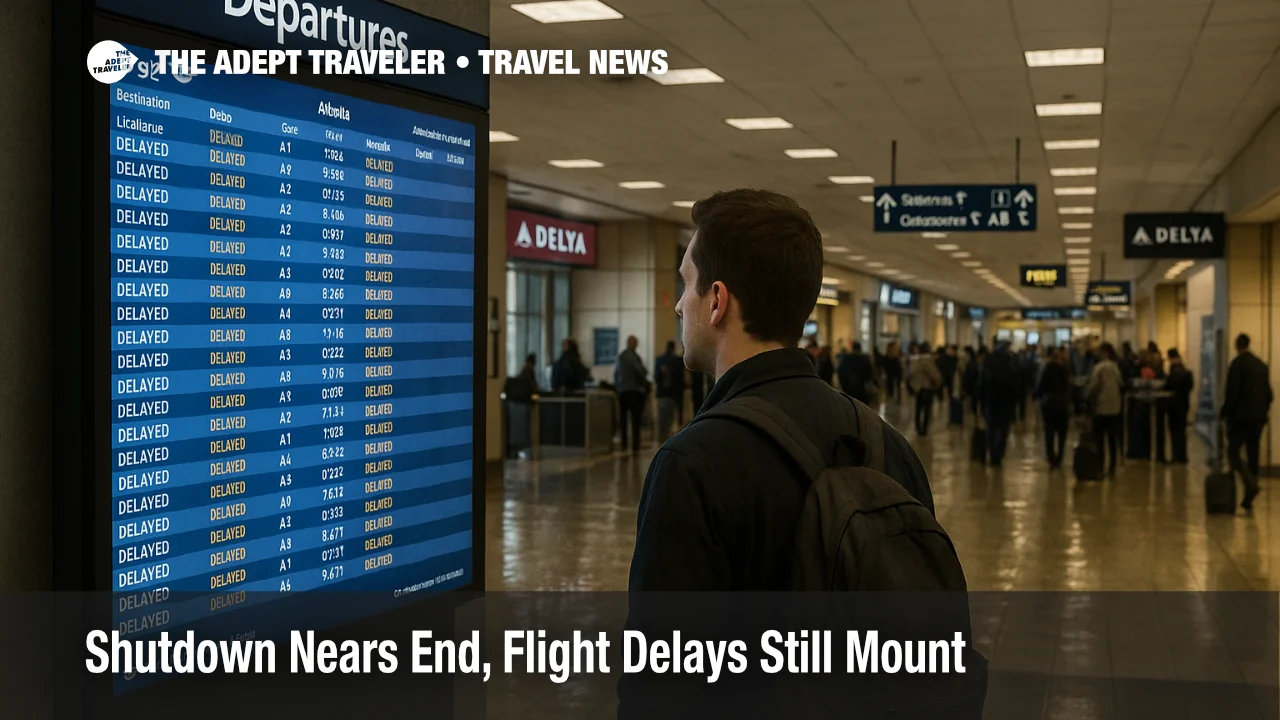Shutdown Nears End, Flight Delays Still Mount

Key points
- More than 1,200 US flights were canceled Tuesday with thousands delayed, per FlightAware
- Senate passed a funding bill and the House could vote as early as Wednesday
- FAA capacity reductions at 40 airports remain in effect and could deepen near term
- Airlines warn of continued disruptions even after a potential government reopening
Impact
- Expect Longer Lines And Slower Boarding
- Plan extra time at check in, security, and boarding, especially at constrained hubs
- Monitor Your Itinerary Hourly
- Use airline apps for rolling retimes and same day reaccommodation
- Use Free Changes If Eligible
- Leverage waivers or refunds posted by your carrier during FAA directed cuts
- Avoid Tight Connections
- Choose longer layovers or nonstop options where possible until cuts ease
- Prepare Backup Ground Transport
- Have rideshare, rail, or coach alternatives for last mile changes
Air travelers faced another difficult day on November 11, 2025, as cancellations topped 1,200 nationwide by late afternoon and delays continued to stack up. The Senate passed a short term funding bill on Monday night that could end the record shutdown once the House votes, yet the Federal Aviation Administration capacity reductions at 40 high volume airports are still in force, and airlines say knock on disruptions will persist.
FAA directed cuts and controller absenteeism
The FAA has been reducing traffic flow at major markets to manage air traffic control staffing shortfalls, initially cutting schedules by 4 percent, then stepping up to 6 percent, and preparing for 10 percent cuts beginning November 14 if needed. Officials have warned that even after funding is restored, there is no immediate timeline for easing the caps because facilities remain strained.
Latest developments
By about mid afternoon on Tuesday, data aggregators showed more than 1,200 cancellations within, into, or out of the United States, plus well over 1,500 delays, with additional preemptive cancellations already filed for Wednesday. Analysts and airlines cautioned that rolling retimes will continue this week while FAA programs meter departures and arrivals at constrained towers and centers.
On the policy track, the Senate approved a funding package on November 11 that would reopen the government once the House acts, with House leaders signaling a possible vote as early as Wednesday. Until a bill is signed, federal pay remains disrupted and absenteeism pressures at facilities can continue to ripple through the system.
In a Monday interview and subsequent social media posts, President Donald Trump criticized absent controllers, said pay could be docked, and floated $10,000 bonuses for those who did not take time off, comments that drew union pushback and added market jitters for airline shares.
Airline responses
Carriers are trimming schedules in line with FAA directives and publishing rolling advisories. American Airlines, for example, detailed FAA required reductions at 40 airports through November 12 and warned of additional same day delays as staffing programs take effect. Similar messaging across the industry emphasizes no fee changes or refunds where required, along with guidance to use mobile tools for auto rebooking.
Union and safety posture
The National Air Traffic Controllers Association said members are working without pay, many under extended duty pressures, and called for an immediate end to the shutdown. Union communications in recent days highlighted the second zero dollar paycheck for controllers and reiterated safety concerns tied to fatigue and facility staffing triggers.
Background
Air traffic control, ATC, facilities use flow programs and ground delay programs to meter traffic when staffing or weather limits capacity. When the FAA orders systemwide cuts, airlines implement advance cancellations to keep the schedule honest, then manage day of operations with reroutes and rolling retimes. Even if Congress reopens the government, it can take days for airlines and crews to realign, and for controllers to clear residual congestion from prior programs. That lag is why multiple outlets and officials are warning that disruptions may continue after a funding bill passes.
Final thoughts
A funding deal would be a necessary step, but not a same day fix. With FAA flow limits still in place at 40 airports and staffing pressures ongoing, travelers should build buffers, avoid tight connections, and keep airline apps open for automatic reaccommodation. Flight delays remain the primary risk, even as the shutdown nears a possible end.
Sources
- Live Airline Flight Cancellations Info and Statistics
- Senate Passes Funding Bill to End Government Shutdown, Sending It to House
- More Than 1,200 Flights Canceled Nationwide on Tuesday, Delays Persist, Tracker Says
- FAA Reducing Air Traffic by 10 Percent Across 40 High Volume Markets During Government Shutdown
- There Is No Timeline On When Flight Cuts Will Ease After The Government Shutdown Ends
- US Airlines Cancel 1,200 Flights Tuesday as Government Shutdown Continues
- Trump Threatens Air Traffic Controllers Who Fail To Return To Work
- Official Statement Of NATCA President Nick Daniels On The Ongoing Government Shutdown
- ICYMI, Press Conference Video As Controllers Receive Second Zero Dollar Paycheck
- U.S. Transportation Secretary Sean P. Duffy and FAA Administrator Bryan Bedford Outline Series Of Safety Measures During Shutdown
- Airlines' Daily Cancellations Top 2,000 For First Time Since Shutdown Cuts Began
